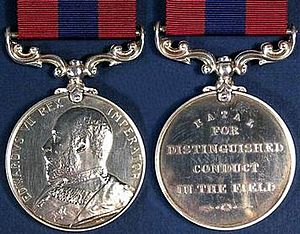Distinguished Conduct Medal (Natal) facts for kids
Quick facts for kids Distinguished Conduct Medal (Natal) |
|
|---|---|
 |
|
| Country | |
| Type | Military decoration for bravery |
| Eligibility | Other Ranks |
| Awarded for | Gallantry in the field |
| Status | Discontinued in 1913 |
| Post-nominals | DCM |
| Statistics | |
| Established | 1897 |
| Order of Wear | |
| Next (higher) | Union of South Africa Queen's Medal for Bravery, Gold |
| Equivalent | Distinguished Conduct Medal |
| Next (lower) | Conspicuous Gallantry Medal |
| Related | Distinguished Service Order |
Ribbon bar |
|
The Distinguished Conduct Medal (Natal) was a special award for bravery. It was given to soldiers in the Colony of Natal, which is now part of South Africa. This medal, often called the DCM, recognized soldiers who showed great courage in battle.
In 1895, Queen Victoria allowed different colonies to create their own versions of British military awards. The Colony of Natal started this system in August 1895. Two years later, in 1897, they created their own Distinguished Conduct Medal.
Contents
What is the Distinguished Conduct Medal?
The original Distinguished Conduct Medal was created by Queen Victoria in 1854. This happened during the Crimean War. It was an award for brave actions by soldiers who were not officers in the British Army.
This medal was the second highest award for bravery for these soldiers. Only the Victoria Cross was considered more important. The DCM was like the Distinguished Service Order, which was given to officers. Soldiers who received the Distinguished Conduct Medal could use the letters DCM after their name.
Natal's Military Forces
In the late 1800s, the Colony of Natal had its own armed groups. These included the Natal Police, which was like a police force but also acted as soldiers. There was also a group called the Volunteer Force.
In 1904, the Volunteer Force was reorganized and renamed the Natal Militia. Later, in 1908, the Natal Police and Natal Militia joined together. They formed the Natal Colonial Forces.
How the Medal Was Created
On May 31, 1895, Queen Victoria gave permission for colonies to create their own military medals. The Colony of Natal quickly adopted this idea in August 1895. The Distinguished Conduct Medal (Natal) was one of three medals created by Natal under this new rule in 1897.
Even after Natal became a province of the Union of South Africa in 1910, the medal was still awarded. It was used until June 1913. That's when the Union of South Africa created its own new medals for its military.
How Medals Were Ranked
Medals have an "order of wear," which means how important they are compared to others. The Distinguished Conduct Medal (Natal) was considered just as important as the original British Distinguished Conduct Medal.
It was ranked after the Union of South Africa Queen's Medal for Bravery, Gold. This was a civilian award for bravery. The Natal DCM was ranked before the Conspicuous Gallantry Medal.
Medals in South Africa
On April 6, 1952, the Union of South Africa created its own set of military awards. These new South African medals were worn before most older British medals. The only exception was the Victoria Cross, which remained the highest award.
Of the British medals given to South Africans, the Natal DCM was ranked after the Air Force Cross.
Medal Design
The Distinguished Conduct Medal (Natal) was made of silver. It was a round medal, about 36 millimeters wide and 3 millimeters thick. It had a fancy hanger at the top to attach it to a ribbon.
Front of the Medal
The first medals, made during Queen Victoria's time, showed a "Trophy of Arms." This was a design with weapons and a shield in the middle. The shield had the Royal Coat of Arms on it.
After King Edward VII became king in 1902, the design changed. The front of the medal then showed his picture. Around the edge, it said "EDWARDVS VII REX IMPERATOR," which means "Edward VII, King and Emperor."
Back of the Medal
The back of the medal was smooth. It had a raised edge. In the middle, it said "FOR DISTINGUISHED CONDUCT IN THE FIELD" in four straight lines. Above this, in a curve, it said "NATAL." Below the words, there was a small laurel wreath and two spear blades.
Ribbon
The ribbon for the Natal DCM was the same as the British Distinguished Conduct Medal. It was 32 millimeters wide and crimson (a deep red color). In the middle, it had a 10-millimeter wide navy blue stripe.
Who Received the Medal?
Out of the four colonies that formed the Union of South Africa in 1910, only Natal actually awarded its version of the DCM. The Cape of Good Hope and Transvaal Colony also had their own versions, but they didn't award them.
Only ten Distinguished Conduct Medals (Natal) were ever given out.
- One was awarded in 1901 during the Second Boer War. This medal had Queen Victoria's "Trophy of Arms" design.
- Nine were awarded for bravery during the Zulu Rebellion in 1906. These medals featured King Edward VII's picture.
In June 1913, the Union of South Africa created its own DCM. However, this version was never awarded. Instead, South African soldiers received the British version of the DCM during the two World Wars.

